If somebody else has already linked these concepts with valid research, they made a theoretical framework which can be used as a 'ready made map' for. The Examples of theoretical framework Must demonstrate an understanding of the theories and concepts that are relevant to the research. A Theoretical Framework for Physics Education Research: Modeling student thinking. Redish VarennaPre.pdf (723.9Kb).
Chapter 2
Theoretical Framework
This chapter consists of concepts, and together with their definitions and reference to relevant scholarly literature, existing theory that will guide the proponent to come up with the utmost solution to the present problem. This chapter also shows the structure that can hold or support a theory of the design project.t
Review of Related Literature and Studies
History of Reverse Osmosis
Reverse Osmosis is a modification of the natural process known as osmosis. A French scientist first described the phenomenon of osmosis in 1748. This scientist noted that water spontaneously diffused through a pig bladder membrane into alcohol. Over 200 years later, researchers modified the process of osmosis and discovered and patented the process now known as reverse osmosis. The reverse osmosis allows the purification of contaminated water by removing dissolved and suspended matter. Reverse Osmosis has become a key process technology. Its use in industrial applications has had major advancements since the early 1960s.
Osmosis and Osmotic Pressure
Reverse Osmosis is a process that separates impurities from water by passing the water through a semi-permeable membrane. The semi-permeable membrane only allows very small atoms and group of atoms such as water molecules, small organics molecules, and gasses to go through it. Hydrated ions, or ions that have been dissolves and are therefore surrounded by water molecules, cannot pass through the membrane. In order to understand reverse osmosis, the osmosis process needs to be understood.
Osmosis and its Cause
When two solutions with different dissolved mineral concentrations are separated by a semipermeable membrane, water flows from the less concentrated to the more concentrated solution. The water level rises on the concentrated side of the apparatus.
The dilution of the solution with the higher concentration is caused by the process called osmosis. The simple definition of osmosis is the tendency of a fluid to pass through a somewhat porous membrane until the concentration on both sides is equal. Osmosis is the migration of water molecules across a membrane caused by the attraction of the dipole moment of water molecule to ions and polar molecule on the other side of a membrane.
Reverse Osmosis is a process that forces water molecules to flow against a net osmotic pressure. This is accomplished by applying enough pressure on the high concentration side of a semi-permeable membrane to reverse the net migration of water molecules.
Creately helps you do this with
A Theoretical Framework For Backpropagation

Guide and Best Practices
A conceptual framework is an analytical tool that is used to get a comprehensive understanding of a phenomenon. It can be used in different fields of work and is most commonly used to visually explain the key concepts or variables and the relationships between them that need to be studied.
How to make a conceptual framework
- Select a topic for your research. It’s better to make sure that the research topic is within your field of specialization.
- Carry out a literature review to understand what research has already been done on the subject matter. Stick to reliable resources such as scientific journals, books and scholarly articles.
- Look for the specific variables explained in the literature and examine the relationship between them.
- Make sure that your thesis contributes something new to what’s already out there and refine your argument or hypothesis based on the literature review.
- Create your conceptual framework; it can be in the form of a flowchart, mind map or concept map. Display the flow of your research and show which variables influence the different components of your research.
- With the conceptual framework, include a narrative which explains in-depth the variables influencing your research and the research methodology.
- As you carry out your research, you may come across data that can prove your hypothesis wrong. Return to your conceptual framework and revise it accordingly.
- If you wish to publish your conceptual framework in a blog or website, you can quickly embed it with Creately Viewer. Or you can export it as a PDF or image to include in PowerPoint presentations and Word docs.